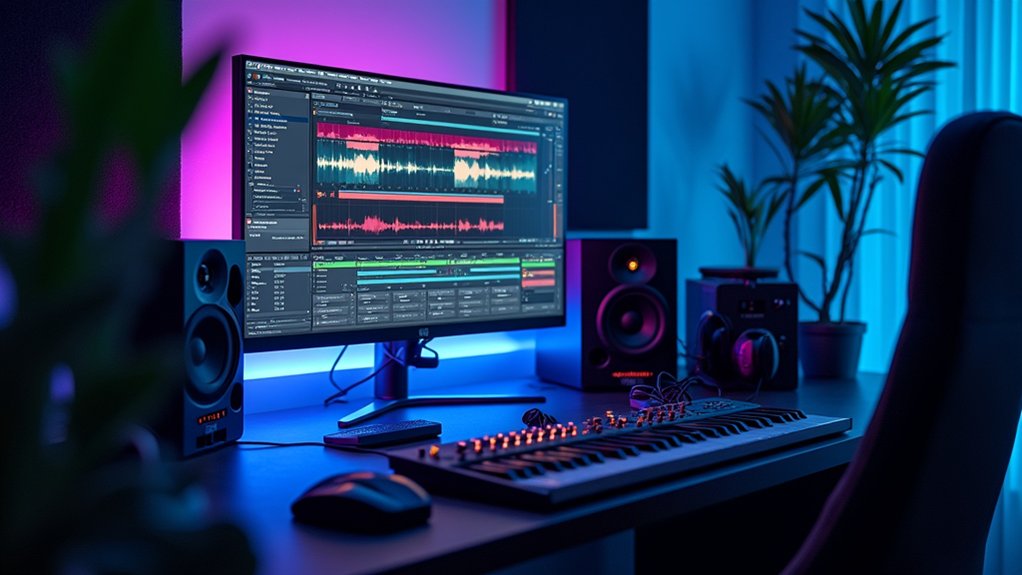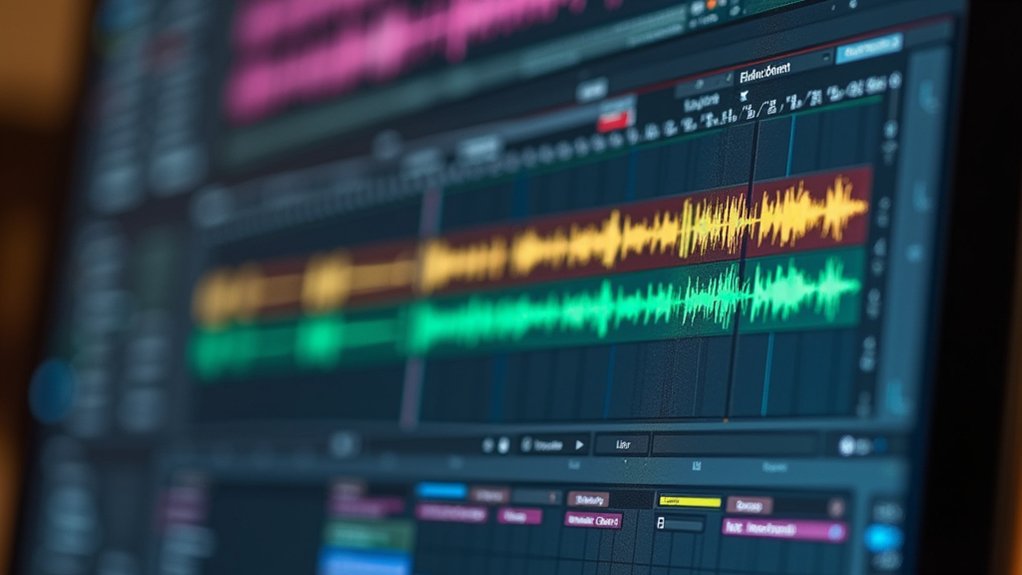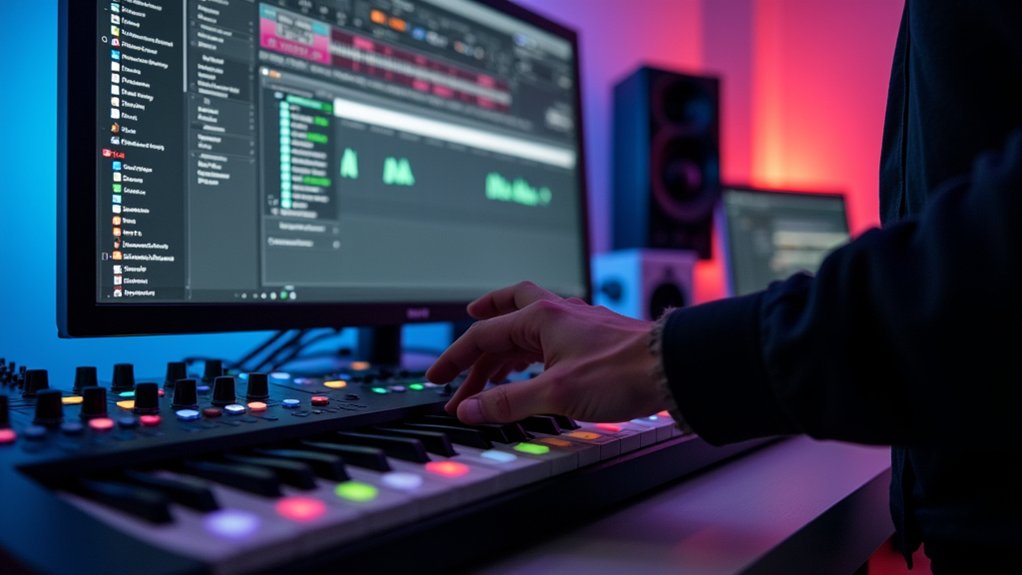Producers seeking FL Studio alternatives have several strong options. Ableton Live excels in live performance and creative workflows, while Logic Pro offers an extensive suite for Mac users. Cubase stands out for advanced MIDI composition, and Reaper provides affordable flexibility with deep customization. Free choices like Cakewalk and LMMS cater to budget-conscious creators. Each DAW has unique advantages, so exploring specific features and workflow compatibility can guide the best decision in the sections ahead.
Key Takeaways
- Ableton Live excels for electronic music with its unique session view, real-time performance features, and advanced MIDI editing tools.
- Logic Pro offers a comprehensive suite of integrated plugins, massive sound libraries, and macOS-optimized performance for Apple users.
- Cubase stands out for advanced MIDI sequencing, robust composition tools, and detailed chord track features for intricate arrangements.
- Reaper provides a cost-effective, highly customizable DAW with advanced MIDI/audio routing and cross-platform support for budget-conscious producers.
- Free alternatives like LMMS, Cakewalk by Bandlab, and Tracktion Waveform Free deliver core music production features without the cost.
Key Considerations When Choosing a DAW
When selecting a digital audio workstation (DAW), several key factors should be systematically evaluated to confirm the software aligns with individual production requirements. Compatibility is paramount; users must confirm that the DAW supports their operating system, whether Windows or macOS. The ease of use and user experience are critical, especially for beginners, as intuitive interfaces can greatly streamline the learning curve. The features offered—such as MIDI editing, built-in instruments, and audio effects—should match the producer’s workflow and support both modern and traditional recording techniques. Price remains a notable consideration, with many DAWs providing tiered pricing or free trials to assess value prior to purchase. Ultimately, a careful analysis of these aspects confirms the DAW complements both creative and technical needs. When choosing a DAW, it’s also important to consider minimum requirements for optimal performance, such as having a robust processor and sufficient RAM to handle complex tasks efficiently.
Ableton Live: The Performance Powerhouse
Ableton Live distinguishes itself with a session view that encourages creative experimentation and flexible arrangement of musical ideas.
Its integration of live performance features, including real-time tempo synchronization and hardware compatibility, supports both solo artists and collaborative setups.
Additionally, the introduction of advanced MIDI tools in recent updates further enhances its appeal for producers seeking precise control and innovative workflow options.
Session View Creativity
While many digital audio workstations adhere to a traditional linear workflow, the session view in Live distinguishes itself through a flexible, non-linear interface designed to foster experimentation and real-time creativity. This unique feature supports live performances by enabling users to trigger individual clips and loops, encouraging improvisation and dynamic arrangement. Live 12 further enhances this environment with advanced MIDI tools, making creative workflows even more seamless. The session view’s capacity for immediate manipulation allows artists to collaborate efficiently, especially when paired with Ableton Link for synchronized tempo across devices. The Push 3 controller introduces a hands-on approach, giving tactile access to session view functions.
| Creativity | Improvisation | Hands-on Approach |
|---|---|---|
| Clip Launch | Live Loops | Push 3 Control |
| MIDI Tools | Spontaneity | Tactile Editing |
| Collaboration | Sync Devices | Real-time Input |
| Arrangement | Flexibility | Direct Feedback |
Live Performance Integration
Few digital audio workstations offer the degree of real-time control and adaptability found in Ableton Live, making it a standout choice for live performance integration.
Its unique workflow, centered around the session view, enables artists to audition, trigger, and manipulate audio clips instantly, a vital feature for dynamic stage environments.
Ableton Live’s compatibility with MIDI controllers—especially when paired with the Push 3—transforms the software into a tactile instrument, allowing hands-on creative tasks without reliance on mouse or keyboard.
Seamless tempo synchronization via Ableton Link guarantees tight coordination across multiple devices and performers, enhancing collaborative live sets.
Integration with any audio interface is straightforward, further reducing technical barriers and empowering musicians to focus on expressive performance rather than setup complexities.
Innovative MIDI Tools
Harnessing a suite of advanced MIDI tools, Live raises both performance and production workflows by enabling real-time manipulation of MIDI data. Ableton Live’s innovative approach centers on its robust MIDI clip editor, where users can precisely adjust note velocity, length, and timing to enhance musical expression. Integration with Max for Live extends these capabilities, offering a diverse range of user-generated tools for sophisticated MIDI manipulation and experimental sound design. Live 12 introduces new MIDI devices, further expanding creative options and workflow efficiency. Additionally, Ableton Link guarantees seamless tempo synchronization across multiple devices, making collaborative performance straightforward.
| Feature | Functionality | Benefit |
|---|---|---|
| MIDI Clip Editor | Precision editing | Expressive musical control |
| Max for Live Integration | Custom MIDI tools | Advanced manipulation |
| New MIDI Devices | Expanded creative options | Unique sound design possibilities |
| Ableton Link | Tempo synchronization | Collaborative performance |
Logic Pro: Apple’s Comprehensive Studio Solution
Logic Pro distinguishes itself through a robust collection of integrated plugins and production tools, catering to a wide range of creative needs within a single environment.
Its macOS-exclusive design guarantees seamless system integration and optimized performance for Apple users.
This combination positions Logic Pro as a compelling choice for those seeking an extensive, all-in-one studio solution on Mac platforms.
Integrated Plugins and Tools
With more than 70 integrated plugins encompassing software instruments, audio effects, and MIDI effects, Apple’s Logic Pro delivers a thorough toolkit for modern music production.
This music production software equips users with advanced features such as Smart Tempo for dynamic tempo adjustments and Flex Time for detailed audio editing, supporting a streamlined workflow.
The inclusion of Live Loops offers a non-linear creative environment, enabling experimentation and rapid arrangement of musical ideas.
Logic Pro’s sound libraries are extensive, providing over 1,000 patches and 10,000 loops that cover a wide spectrum of genres and production styles.
Additionally, ARA (Audio Random Access) support integrates third-party audio editing tools like Melodyne, enhancing production flexibility.
Macos-Exclusive Workflow
Although limited exclusively to macOS, Logic Pro delivers a deeply integrated music production environment tailored to Apple’s hardware and software ecosystem.
Its macOS-exclusive status guarantees seamless compatibility and optimization, making it a top choice for those invested in Apple products.
Logic Pro’s user-friendly interface streamlines recording and mixing, catering to both novices and professionals.
The DAW stands out with a robust collection of bundled plugins and expansive sound libraries, enhancing creative possibilities.
Notable 2024 updates, such as AI-powered session musicians and ChromaGlow for added sonic warmth, further boost its appeal.
- Effortless workflow through intuitive recording and mixing tools.
- Extensive bundled plugins and curated sound libraries for diverse genres.
- Advanced features like built-in stem splitter and AI-driven enhancements for modern music production.
Cubase: Advanced MIDI and Composition Tools
While many digital audio workstations offer basic MIDI sequencing, Cubase distinguishes itself through its advanced MIDI editing capabilities and extensive composition tools.
Cubase provides users with thorough MIDI editing functions, enabling the creation of intricate arrangements and seamless manipulation of MIDI data. Its robust chord track feature enhances the composition process by facilitating harmonic planning and visualizing chord progressions, making it particularly valuable for songwriters and arrangers.
The inclusion of a broad selection of virtual instruments and over 30 effects supports flexible sound design and high-quality audio production. Additionally, Cubase’s dynamic project window allows for efficient organization and management of tracks during composition.
Full support for VST3 plugins further expands creative options, ensuring compatibility with a wide array of third-party instruments and effects for versatile music production.
Reaper: Affordable Flexibility for Home Studios
Beyond Cubase’s advanced MIDI and composition tools, Reaper stands out as a cost-effective solution tailored for home studios seeking flexibility without compromising capability.
As an affordable DAW, Reaper offers personal licenses at $60, making it accessible for budget-conscious musicians and producers. Its cross-platform compatibility (Windows, macOS, Linux) guarantees seamless use across various systems.
Reaper’s highly customizable interface allows users to adapt the workspace, even emulating other DAWs for easier workflow changes. Advanced MIDI and audio routing provide robust editing features, making it suitable for complex production setups. Frequent updates and a responsive interface further enhance its usability.
Key highlights of Reaper for home studios include:
- Budget-friendly licensing and extensive trial period
- Deeply customizable user interface
- All-encompassing MIDI and audio editing features
Free FL Studio Alternatives Worth Trying
Several free digital audio workstations (DAWs) offer compelling alternatives to FL Studio, delivering essential music production features without the cost.
LMMS stands out among free DAWs for electronic music, providing unlimited track recording/playback and VST plugin support across Windows, Linux, and Mac.
Cakewalk by Bandlab presents a robust option for Windows users, featuring extensive MIDI and VST integration, suitable for both advanced users and DAWs for beginners.
Stagelight, with its Ableton Live-inspired interface, appeals to those seeking a streamlined workflow, while offering in-app purchases for added functionality.
Tracktion Waveform Free expands creative possibilities with MIDI/audio track capabilities, sample-based instruments, and VST/AU compatibility.
Collectively, these free DAWs guarantee accessible, versatile options for producers at various skill levels and budgets.
Frequently Asked Questions
Which DAW Is Most Similar to FL Studio?
When analyzing DAW comparisons, LMMS is most similar to FL Studio with regard to software interfaces, workflow efficiency, plugin compatibility, and genre versatility. Its music production environment closely replicates key FL Studio features, making it a strong alternative.
What Is the Best FL Studio Alternative?
Evaluating the best FL Studio alternative requires considering user needs. Cubase Software offers extensive features, while Ableton Live excels for electronic genres. Logic Pro, Studio One, Reason Essentials, Cakewalk Sonar, and Reaper DAW each provide distinct advantages for producers.
What DAW Does Ed Sheeran Use?
Ed Sheeran’s setup primarily features Logic Pro as Ed Sheeran’s software of choice, central to Ed Sheeran’s production and workflow. Ed Sheeran’s gear often includes Logic’s virtual instruments, supporting live recording in Ed Sheeran’s studio and collaborations.
What DAW Did Kanye Use?
Kanye West’s production often involves FL Studio for crafting Kanye beats and manipulating Kanye samples, while Ableton Live and Pro Tools are used for Kanye collaborations, songwriting, and mixing, reflecting varied Kanye influences across his albums.
Conclusion
Selecting the right DAW hinges on individual needs, workflow preferences, and budget. While FL Studio remains a popular choice, alternatives like Ableton Live, Logic Pro, Cubase, and Reaper each offer distinct strengths, from live performance tools to advanced MIDI editing. Free options further broaden accessibility. By carefully evaluating features, compatibility, and personal priorities, producers can identify the DAW best suited to their creative and technical requirements, ensuring a productive and inspiring music-making environment.




